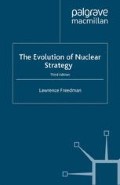Abstract
It might be thought that the introduction of nuclear weapons created a wholly unprecedented situation rendering all previous strategic theories and concepts immediately obsolete. In fact such a demarcation line is hard to establish. The concepts with which nuclear weapons were first understood were derived from a prior era; many of the post-1945 debates were, in essence, continuations of those of pre-war days. The main link was provided by the doctrine of strategic bombardment, which assumed that the most effective use of aircraft was to attack the social and industrial heart of the enemy, so producing internal collapse and obviating the need for a traditional battlefield victory. Support for this doctrine grew with the quality of aircraft performance and also out of the desire to avoid a repetition of the murderous stalemate of the Great War.
Preview
Unable to display preview. Download preview PDF.
Notes
Quoted in George Quester, Deterrence Before Hiroshima: The Influence of Airpower on Modern Strategy (New York: John Wiley, 1966), p. 52.
Giulio Douhet, The Command of the Air, as translated by Dino Ferrari (New York: Coward-McCann Inc., 1942), pp. 220, 202.
The efforts to secure formal international agreement on restraint are described by Donald Cameron Watt in ‘Restraints on war in the air before 1945’, in Michael Howard (ed.), Restraints on War: Studies in the Limitation of Armed Conflict (London: Oxford University Press, 1979).
B. H. Liddell Hart, The Revolution in Warfare (London: Faber & Faber; 1946), p. 31.
David Irving, The Mare’s Nest (London: William Kimber, 1964), pp. 181, 210, 291, 294.
Richard G. Hewlett and Oscar Anderson, The New World 1939/46: vol. I of a history of the ASAEC (Pennsylvania: Pennsylvania University Press, 1962);
Margaret Gowing, Britain and Atomic Energy, 1939–1945 (London: Macmillan, 1964).
Henry L. Stimson and McGeorge Bundy, On Active Service in Peace and War (London: Hutchinson, 1948), p. 361.
Herbert Feis, The Atomic Bomb and the End of World War 11, (Princeton: Princeton University Press, 1966), p. 87; Margaret Gowing, op. cit., p. 106.
This is discussed in detail in Lawrence Freedman, ‘The strategy of Hiroshima’, The Journal of Strategic Studies, i, 1 (May 1978).
Quoted by L. Giovannitti and F. Freed, The Decision to Drop the Bomb (London: Methuen & Co., 1967), p. 35.
Leslie R. Groves, Now It Can Be Told: The Story of the Manhattan Project (New York: Harper, 1962) p. 267.
Robert J. C. Butow, japan’s Decision to Surrender (Stanford: Stanford University Press, 1954), p. 180.
Author information
Authors and Affiliations
Copyright information
© 2003 Lawrence Freedman
About this chapter
Cite this chapter
Freedman, L. (2003). The Arrival of the Bomb. In: The Evolution of Nuclear Strategy. Palgrave Macmillan, London. https://doi.org/10.1057/9780230379435_1
Download citation
DOI: https://doi.org/10.1057/9780230379435_1
Publisher Name: Palgrave Macmillan, London
Print ISBN: 978-0-333-97239-7
Online ISBN: 978-0-230-37943-5
eBook Packages: Palgrave Political & Intern. Studies CollectionPolitical Science and International Studies (R0)

